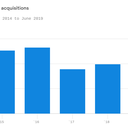Big Pharma's buying spree isn't stopping anytime soon

Published Date: 6/26/2019
Source: axios.com
Data: 2019 EY M&A Firepower report and Axios reporting; Chart: Axios VisualsThe pharmaceutical industry has already shelled out more than $200 billion for acquisitions during the first half of 2019, capped off yesterday by AbbVie's $63 billion buyout offer for Allergan.The big picture: This year's deal-making has already surpassed 2017 and 2018, as drug companies plan for patent losses and jockey for lucrative assets that are advancing in clinical trials, including gene therapies.Driving the news: The AbbVie-Allergan combination makes 2019 one of the busiest for pharmaceutical deals in the past several years.Bristol-Myers Squibb's $74 billion deal for Celgene remains the largest so far this year.But there's also GE Healthcare's $21 billion selloff of its biopharma assets to Danaher; Pfizer's $11 billion deal for Array BioPharma; Eli Lilly's $8 billion acquisition of Loxo Oncology; Roche's $5 billion deal for Spark Therapeutics; and numerous other 9- and 10-figure buyouts and bolt-on acquisitions.More acquisitions are on the horizon.The running theme in almost all of these deals: scoop up cancer drugs and gene therapies, which command the highest prices.Yes, but: AbbVie-Allergan is different. Wall Street has been down on both companies, and this buyout is focused on Allergan's aesthetics drugs, like Botox. It's largely about protecting economic moats, based on AbbVie CEO Richard Gonzalez's comments.The big question: The Federal Trade Commission is increasing its scrutiny of pharma mergers, including BMS-Celgene and Roche-Spark. So, don't assume every deal will get clean antitrust approval."There will be some divestment" in the AbbVie-Allergan combo because the companies have some overlap with gastrointestinal medicines, Bernstein analyst Ronny Gal wrote to investors.The bottom line: These companies have been sitting on piles of cash, and now they want to spend that money to get new returns for their investors — all while patients stare down the barrel of unaffordable medications and even more expensive future treatments.Go deeper: Why pharma companies merge